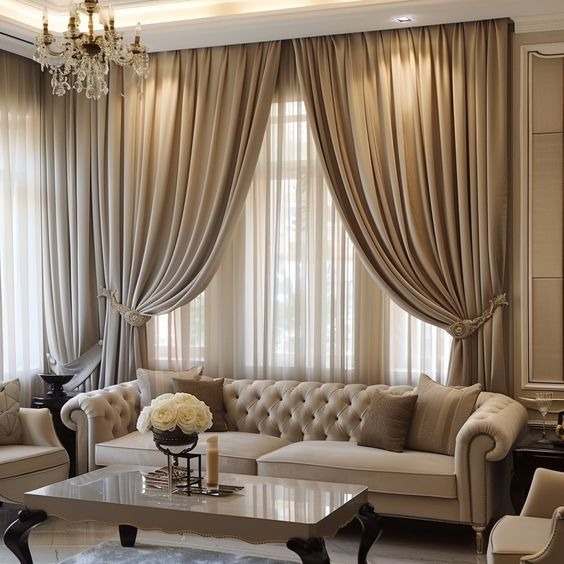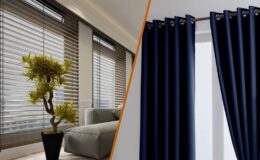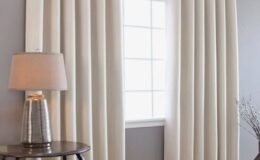Curtains do more than frame windows because they influence how a room feels, functions, and holds up under daily life. In a city like Dubai, where sunlight pours through glass most of the day and the heat can linger long past sunset, fabric choices play a big role in how well curtains age and perform.
The wrong material fades quickly, traps heat, or becomes hard to clean. Meanwhile, the right one blocks excess glare, filters light comfortably, and complements the room’s temperature all year. In this blog by The Dubai Curtain Shop, we explore how to pick the right Perfect Curtains Fabric For Dubai Weather that doesn’t just look good, but actually works with Dubai’s demanding climate.
Understand How the Perfect Curtains Fabric For Dubai Weather Influences Comfort in Dubai Interiors
It’s not just about style—fabric weight, weave, and structure decide how much light and heat enters your room.
1. Why Fabric Type Is the First Decision to Get Right?
Choosing curtain fabric begins with purpose. Some rooms need privacy. Others need daylight. A few demand insulation. In Dubai, rooms facing direct sunlight need something more than just sheer style. Polyester blends, cotton weaves, and linen look-fabrics all behave differently. Polyester handles sun without fading.
Cotton breathes better in closed spaces. Linen softens the room’s glare and movement. Each one filters and reflects differently. Your choice affects both the room’s lighting and how hot the space gets in the afternoon. Getting this wrong means fabric that yellows, stiffens, or fades within a few months.
2. Light Control: Sheer vs. Semi-Opaque vs. Full Blackout
Every room doesn’t need the same amount of light control. In living rooms, sheer fabrics soften the sun’s edge but still keep the mood bright. In bedrooms, semi-opaque cotton blends block out enough to encourage good rest without turning the space into a cave.
Full blackout curtains, often lined with a heavier synthetic base, help in nurseries or media rooms where darkness improves comfort. A smart pick might be double-layered curtains to enjoy a sheer daytime panel and a heavier nighttime layer. This combo keeps energy use low and comfort high.
3. Heat Resistance Without Sacrificing Style
Dubai’s heat doesn’t just make a room uncomfortable. It also ruins fabric faster. Curtain fabrics must resist shrinking, yellowing, or curling at the edges. Polyester and acrylic blends hold their shape longer, especially in floor-length styles. Natural materials like linen or cotton need linings or backing to stay strong.
Heat-resistant weaves or UV-treated layers reflect sunlight without looking shiny or plastic. Choosing colors that reflect rather than absorb sunlight helps reduce the fabric’s internal heat load. With the right blend, you get long-lasting curtains that don’t feel industrial.
4. Texture and Feel: Avoiding Heavy Fabrics That Trap Warmth
Thick velvet or brocade may work in cooler climates, but in Dubai, they can over-insulate the space. They trap heat, slow air flow, and rarely get cleaned properly. Instead, opt for lighter textures that drape softly without clinging to the windows.
Soft-touch linen, cotton sateen, or open-weave polyester gives a breathable texture without looking too flimsy. A fabric that moves with the breeze, rather than stiffening under the air conditioner, adds a lived-in feel. Texture is still essential, but it needs to behave well with Dubai’s long dry spells.
5. Color Choices That Support Climate Control
Curtain color impacts more than mood. In high-light interiors, darker tones fade quickly. They also absorb more heat, raising the room’s temperature. Lighter tones such as white, beige, cool gray, muted sand bounce light back and resist fading.
But don’t go purely pale. Mid-toned neutrals maintain visual warmth without showing dust easily. If color is essential, use it in patterns layered over a base of heat-resilient shades. This approach lets you enjoy bolder interior ideas while staying practical. Always choose fade-resistant dyes, especially for sun-facing walls.
6. Choosing Lining That Matches the Room’s Purpose
Lining gives your curtain extra strength. For daytime sitting rooms, cotton or thermal lining helps moderate interior temperature. In bedrooms, blackout lining prevents early morning light. Kitchens and laundry spaces may not need lining but benefit from mold-resistant fabrics.
A good lining helps the curtain hold shape, fall properly, and age more evenly. In many cases, it’s the difference between flimsy and full. And if you ever plan to machine wash, make sure both outer fabric and lining are compatible.
7. Dust Resistance and Maintenance Considerations
Dust builds up quickly in Dubai homes, especially around windows. Choosing curtain fabrics that resist static or hold less dust means fewer washes and better air quality. Polyester and poly-cotton blends tend to repel dust better than pure cotton or velvet.
Lightly textured fabrics show fewer prints and marks. If you prefer natural fabrics like linen or jute, plan for regular vacuuming or dusting. Pick fabrics with tight weaves that don’t fray easily. And always confirm the curtain is machine-wash safe or easy to steam clean.
8. Draping and Stitching: Structure Helps with Climate Adaptation
The way curtains fall affects how well they block or diffuse light. Fabrics that crumple too easily may bunch at the edges, letting heat in. A medium-weight weave that falls in consistent folds works better. Choosing the Perfect Curtains Fabric For Dubai Weather means selecting materials that hold their shape and flow smoothly to enhance climate control.
Stitching matters too because curtains with reinforced edges and lined hems are less likely to curl or stretch in the heat. Curtain rods should allow slight movement, so air can flow. Tiebacks and loose rings help with that. In Dubai, curtain structure is about more than visual polish, it’s about regulating airflow and light exposure hour to hour.
9. Eco-Friendly Curtain Fabrics for Sustainable Homes
Natural fabrics often feel better for the environment, but not all are heat-tolerant. Bamboo, linen, and recycled cotton offer eco-value, but they need special care. Polyester blends with recycled content, treated for heat resistance, are often more durable in sun-heavy homes.
Fabric certifications (OEKO-TEX, GRS) help you spot safe, toxin-free options. Eco-aware curtain shopping doesn’t mean sacrificing comfort, it means making choices that perform well and last longer, which is sustainability in itself.
10. Matching Fabric to Room Type and Usage
A one-size-fits-all curtain fabric doesn’t exist. In bedrooms, blackout polyester blends help create restful spaces. In living rooms, open-weave linen or cotton blend curtains let daylight soften the room without overheating it.
Kitchens or utility areas do better with shorter curtains made from washable poly-linen. Children’s rooms benefit from UV-stable fabrics in cheerful tones that can handle both sunlight and stains. Understanding what each room demands helps ensure your choice lasts and feels tailored, not just installed.
The Takeaway
Curtains don’t just hang for style, they influence light, temperature, mood, and comfort. In Dubai’s sun-drenched climate, curtain fabrics must stand up to glare, heat, and dust without fading fast or feeling heavy. The ideal choice depends on the room’s exposure, function, and feel. Whether you prefer soft natural textures or tech-smart weaves, success lies in knowing what the fabric does; not just how it looks. With the Perfect Curtains Fabric For Dubai Weather in place, you don’t just get curtains.. You get climate control, light balance, and a backdrop that stays beautiful through every season.




